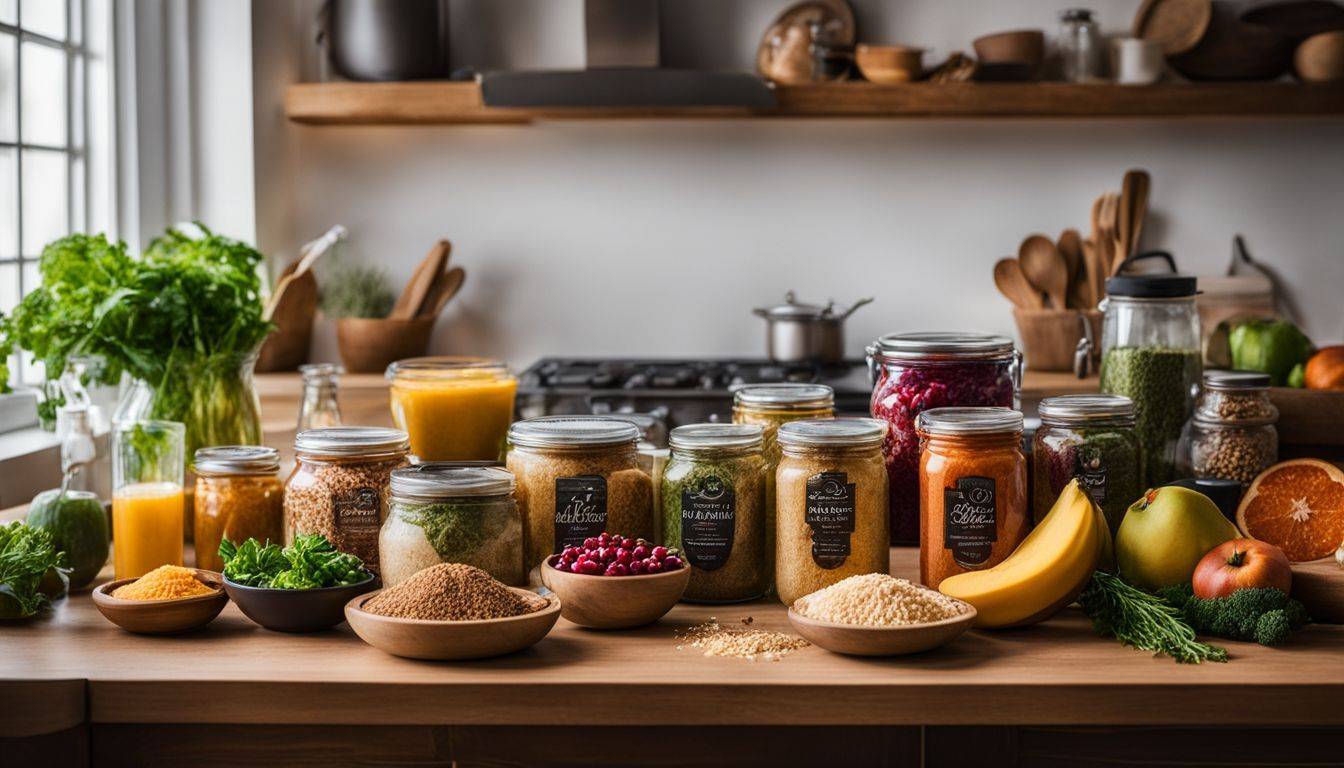Carb cycling is a way to plan your carb intake for better health and fitness. It changes the amount of carbs you eat each day based on your exercises and goals. This method can help keep hunger away, burn more fat, keep insulin levels steady, and give you more energy for workouts.
When you use a carb cycling calculator, it figures out how much energy you use daily so that you can change how many carbs you eat to meet your needs.
On days with lots of exercise, the calculator suggests eating about half your calories as carbs. On calmer days, it says to have fewer carbs—only one-fourth of what you eat. A good carb cycle doesn’t go past 20 weeks at a time without taking a break.
This helps both your body and mind stay healthy.
The right weight loss foods are key in carb cycling too. You should choose things like whole grains and vegetables which give long-lasting energy. The calculator considers who you are—how big or small, active or relaxed—and makes sure the plan fits just right.
Now let’s look closer at why counting carbs this way can do so much for performance in sports and everyday life alike!
Understanding Carb Cycling

Carb cycling means you change how many carbs you eat every day. Some days, you eat more carbs, and other days you eat less. This can help your body in different ways. For example, on days when you work out hard, eating more carbs gives your body the energy it needs.
On rest days or light activity days, eating fewer carbs helps your body burn fat for fuel instead.
This way of eating works well with exercise routines to help people lose weight or get strong muscles without giving up all their favorite carb foods. It can make sure that the body gets just what it needs at the right time.
After learning about carb cycling meal plan, find out why this approach might be good for reaching fitness goals!
Why Use Carb Cycling?

Carb cycling tailors carbohydrate intake to when your body needs it most, optimizing energy usage and fat loss. This strategic approach works in harmony with exercise routines, enhancing results from your fitness efforts.
Suppressing Hunger
Feeling full and satisfied is a big win when you’re trying to stay fit. Carb cycling helps with this because it lets you have high-carb days that can make your stomach feel happy. This mix of low and high carb times keeps hunger away better than just eating the same amount every day.
It means you can enjoy meals with carbs without feeling bad.
On your lower carb days, your body learns to burn fat for energy instead of always reaching for the carbs, which may help munchies not bother you so much. You get to eat yummy carbs like bread and pasta now and then, which makes sticking to your plan easier over time.
The best part? You won’t be fighting off hunger every minute, making getting in shape less tough.
Fat Loss
Eating fewer carbs can help your body burn fat. This is because when you eat less sugar and starch, your body starts using its own fat for energy. Carb cycling gives you a plan to eat the right amount of carbs at the best times to keep muscle but lose fat.
It mixes days with more carbs and days with fewer carbs. On high-carb days, you fuel up for tough workouts. Low-carb days help you burn fat.
Carb cycling might seem tricky, but using a calculator makes it simple. You type in some info about yourself like how active you are and what foods you like. Then, the calculator tells you just how many carbs to eat each day to help melt away body fat while keeping your muscles strong.
It also matches your eating plan with when you exercise so that on rest days, you eat fewer carbs which helps promote weight loss faster.
Insulin Health
Just as shedding extra fat is important for your body, keeping your insulin in check is key for staying healthy. Carb cycling works well to balance your blood sugar levels. This way, it keeps you away from bad spikes and drops that can mess up how insulin works in your body.
When you switch between low carb and high carb days, your body gets better at using insulin. You might stay away from problems like type 2 diabetes and become more sensitive to insulin’s effects.
This means sugars move into muscle cells easier where they can be used for energy instead of turning into fat. By managing carbs smartly with a calculator, you help control blood sugar levels and support a healthy insulin response.
Regularly practicing carb cycling could make cells respond better to insulin over time. It helps avoid the risk of becoming resistant to this important hormone which is needed to keep blood sugar steady.
With proper guidance on how many carbs to eat on each day, anyone looking to get fit can maintain their health while reaching fitness goals faster. More stable blood sugar means less hunger pangs and more consistent energy throughout the day too!
Increased Fat Burning
Eating fewer carbs some days and more on others helps your body burn fat better. This is what carb cycling does for you. It changes how much carbs you eat to match what your body needs that day.
If you work out hard, you eat more carbs to give energy. On rest days, less carbs mean your body uses fat for fuel instead.
This way of eating can make the fat burning process faster, especially if you are active. Your muscles get the right amount of fuel from healthy foods like vegetables and whole grains when they need it most.
And on days off, not having extra carbs around makes sure your stored fat gets used up first for energy needs.
Performance Boost
After fueling your body’s fat-burning abilities, carb cycling takes you to the next level on days when you need it most. Match your high-carb days with intense training sessions and feel the difference in power and stamina.
You can push harder and go longer because your muscles have the energy they crave from carbs.
This smart strategy means workouts sync up with how you eat, letting you build muscle without gaining fat. On tough workout days, extra carbs give muscles quick energy for heavy lifting or sprints.
High-intensity training gets a real boost, helping you get stronger every time you hit the gym or play your favorite sport.
Who Should Use the Carb Cycling Calculator?

If you want to get fit, lose fat, or build muscle, a carb cycling calculator might be for you. People who do intense workouts like lifting heavy weights or long runs can use this tool.
It helps figure out how much food and carbs you need on different days. This way, your body gets the right energy for tough days and doesn’t store extra fat on easier days.
Even if you’re not an athlete but still care about staying healthy, carb cycling could work well. The calculator makes it simple to know when to eat more carbs or less, based on what your body is doing that day.
It’s all about balancing things to keep hunger away and help your insulin work better without cutting out all the carbs from your diet. This method is smart for anyone trying to improve their health without giving up good food.
How to Use a Carb Cycling Calculator

5. How to Use a Carb Cycling Calculator: Uncover your personalized path to optimal fitness results by mastering the simple yet effective steps of our carb cycling calculator—your journey towards a leaner, healthier physique starts here.
Step 1
Find out how much energy your body needs each day. This is called your basal metabolic rate or BMR. The Carb Cycling Calculator helps you know this number for free. Your BMR is the amount of calories you burn just being alive, without adding any extra activities like jogging or lifting weights.
Enter your age, weight, height, and sex into the calculator to get started. It’s important because these details change how many calories you should eat every day to reach your fitness goals.
Using this information, the calculator figures out your daily calorie needs based on whether you want to lose fat, gain muscle, or maintain weight.
Step 2
Enter your fitness goals into the carb cycling calculator. You might want to lose fat or build muscle. The tool uses this information to set up the right plan for you. It tells you how many carbs, proteins, and fats you should eat on different days.
Next, put in what kind of workouts you do and how often. This helps the calculator figure out your energy needs better. If you lift weights or do high-intensity training, it will adjust your food numbers to give you more power on those days.
Step 3
Find your workout plan. You will need to know how often and how hard you exercise. If you do more physical activity, like HIIT or running, your body may need more carbs on those days.
For lighter days, when you might just walk or stretch, less carbs are okay.
Pick the right carb amount for each day based on what type of exercise you do. Use the calculator to adjust the number of carbs so they fit with your workouts. This helps make sure that you have enough energy when exercising and burn fat when resting.
Step 4
Enter your activity level into the carb cycling calculator. This helps figure out how many calories you need each day. Your body burns energy all the time, even when resting. If you move more, you burn more calories.
The calculator uses your activity to make sure you eat enough on high and low carb days.
Make smart food choices with this information. Carb cycling calls for discipline in picking what to eat. Choose foods that are nutritious and will support your fitness goals. Remember, making these choices is key to following a carb cycling plan well.
The Working Mechanism of the Carb Cycling Calculator
The Carb Cycling Calculator takes your personal info and figures out the best plan for you. It looks at things like how much you weigh, your muscle to fat ratio, and what type of body shape you have.
This helps it find out how many calories you burn when resting. From there, it gets even smarter by checking out all the activities you do in a day. That’s how it can tell you exactly how much energy your body uses up.
Next, this handy tool makes a map for your eating. It tells you when to eat more carbs and when to cut back based on your exercise days and goals. If one day you’re working hard, lifting weights or running fast, the calculator suggests eating more carbs that day.
On easier days or rest days, it’ll guide you to fewer carbs so everything stays balanced for fat loss or muscle gain – whatever goal rocks your world!
Example of Carb Cycling Calculation
Let’s say you want to try carb cycling. You’ll have to figure out how many carbs to eat on different days.
– Find your basal metabolic rate (BMR). This is what your body needs to function at rest.
– Multiply your BMR by an activity factor. If you’re active, multiply by a bigger number.
– Get your calorie need. Add extra calories if you want muscle, or cut them for weight loss.
– Decide on the split for high and low-carb days. Maybe 50% carbs on high days and 25% on low days.
– Calculate carbs in grams. Use the percentage and daily calorie need to find grams of carbs.
– Plan meals with these numbers. Pick foods that match the carb amount needed each day.
Now look at good food choices for this plan.
Good Food Choices for Carb Cycling
Eating well is key to carb cycling success. Choose complex carbs like whole grains and oatmeal for long-lasting energy. Sweet potatoes, beans, and legumes are also smart picks because they give you fiber and nutrients.
Add some dried fruits for a quick energy boost but watch the portion sizes.
Don’t forget your veggies! Greens, peppers, broccoli, and other colorful plants help fill you up without many calories. Pick unsweetened plant-based milks as a drink or cereal buddy; they’re low in carbs yet creamy.
Exercising While Carbohydrate Cycling
Carb cycling can make your workouts better. It matches your carb intake with how hard you exercise.
– On days you rest, eat fewer carbs to help burn fat.
– Eat more carbs on days you do tough exercises like lifting weights or running long distances.
– Try extra carbs on one day each week to keep your body guessing and metabolism high.
– During workouts, eating the right amount of carbs gives you energy.
– Listen to your body – it tells you what it needs for different types of workouts.
– Think about the timing: have some carbs before and after working out for fuel and recovery.
– Pick good carbs, like sweet potatoes, that give steady energy without a crash later.
Benefits of Carb Cycling
Unlock the transformative power of carb cycling to elevate your fitness journey, igniting metabolism and fine-tuning body composition for peak performance—dive deeper to discover how this strategic approach can revolutionize your health and fitness goals.
Improves Performance
Carb cycling can make you stronger and boost your workouts. It matches your carb intake to when you need energy the most. On heavy workout days, you eat more carbs to give you power.
When you rest or do light activities, you cut back on carbs. This way helps your body work better and can lead to better fitness results.
With a Carb Cycling Calculator, it’s easy to plan how many carbs to eat for good performance. Whether lifting weights or running, this tool tailors your carb needs just right. So, if you want to feel strong and exercise well, using the calculator can help guide your food choices for top-notch energy levels during workouts.
Promotes Recovery
If you work out hard, carb cycling helps your muscles heal. On days when you eat more carbs, like whole grains and oatmeal, your body gets back the energy it stored in your muscles.
This is good for people who are very active. It lets them bounce back quicker after exercise.
Carb cycling also keeps you from eating too few calories for too long. This can help stop you from feeling worn out or hurt by working out too much. It’s a way to keep fit without getting tired or hurt.
Regulates Appetite
Carb cycling helps you feel full and stop the urge to eat too much. On days with more carbs, your body gets the energy it needs. Then, on low-carb days, your body uses stored fat for fuel.
This switch makes sure you don’t get too hungry or have big drops in energy.
Doing carb cycling can keep your hunger hormones like ghrelin in check. It stops you from craving snacks all the time. You’ll find it easier to stick to a healthy eating plan and reach your fitness goals without feeling starved or worn out.
Improves Insulin Sensitivity
Carb cycling helps your body handle insulin better. This means you match the carbs you eat with how active you are and what energy you need. Eating more carbs can lead to better insulin control, which keeps blood sugar levels stable.
That way, your energy stays balanced all day long.
This method is great for people looking to get in shape or stay fit. It makes sure that after a workout, when muscles need it most, they get enough fuel from carbohydrates. Plus, on rest days, eating fewer carbs can help avoid weight gain and keep blood sugar low.
Considerations and Cautions for Carb Cycling
Carb cycling can be a powerful way to manage your weight and improve fitness. But you need to be careful not to cut calories too much. If you do, it could hurt your metabolism or even make you feel really tired.
Make sure to eat enough so your body doesn’t think it’s starving.
Take breaks from low-carb days now and then. After about 20 weeks of carb cycling, give yourself a “diet break.” This means eating normally for a little while. It helps both your body and mind relax.
The break also makes sure your body keeps working like it should, burning the right amount of energy every day.
Frequently Asked Questions
12. Frequently Asked Questions: Dive into our FAQs for swift answers on carb cycling intricacies, ensuring clarity as you embark on your fitness journey—discover the essentials that cater to your regimen’s success.
How do you calculate carb cycling?
To calculate carb cycling, you first need to know how much energy your body uses each day. This is called your metabolic rate. The calculator will ask about your weight and body type to find this out.
Then it tells you how many calories and carbs you should have on high and low-carb days. Your workout routine and fitness goals are important too, so the calculator can plan what’s best for you.
It makes sure you get enough fuel for energy but not too much so that your body starts storing fat.
Your personal carb cycling plan will show different amounts of carbs for different days of the week based on what you tell it about yourself. On days when you exercise a lot, it might tell you to eat more carbs to keep up with extra energy needs.
But on rest days or light workout days, it suggests fewer carbs since your body doesn’t need as much power. This way, the carb cycling helps balance everything — hunger, fat loss, muscle building — while keeping blood sugar in check.
What macros should I split for carb cycling?
For carb cycling, you need to know how much protein, fat, and carbs to eat. Protein stays the same each day. It helps keep your muscles strong. Eat a bit of fat every day too for good health.
On low carb days, you eat fewer carbs so your body burns more fat. But on high carb days, you eat more carbs so you have lots of energy for workouts and building muscle.
Pick which days are high or low in carbs based on when you exercise most. Use the calculator to get the right amounts for your personal goals like losing weight or getting fit. It’s important not to get this wrong because it could make you feel tired or not perform as well during exercise if done incorrectly.
What is the best carb cycling schedule?
The best carb cycling schedule matches your workouts. On days you rest, eat fewer carbs. When you work out, have a medium amount of carbs. Choose one day each week for eating more carbs to help your metabolism.
This plan helps your body use the right energy at the right time.
Eating good foods is key while following this schedule. Next, let’s talk about what foods work well with carb cycling!
What is the ratio for carb cycling?
Finding the right balance is key to a successful carb cycling plan. Your body gets different amounts of carbs on different days. On high carb days, aim for 50% of your calories to come from carbs, with protein at 30% and fat at 20%.
Switch it up on low carb days: only 25% of your calories should be from carbs, but keep protein the same and increase fat to 45%. This mix helps you work out hard when you have lots of energy from carbs and burn fat when you eat less.
Remember, keeping track of what you eat will help make sure you’re hitting these targets to get fit!
Conclusion
Remember how carb cycling can change your fitness journey. Using a carb cycling calculator makes it easy to plan your meals. You get to eat more carbs on some days and less on others, depending on your workout.
This helps you lose weight and keep muscle. Try different foods and stay active for the best results. Let the carb cycling calculator guide you toward reaching your health goals!
